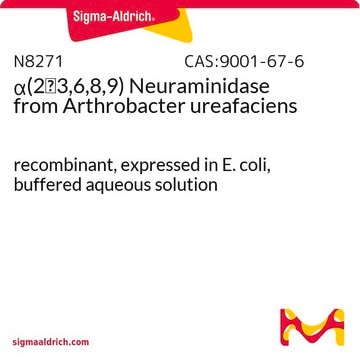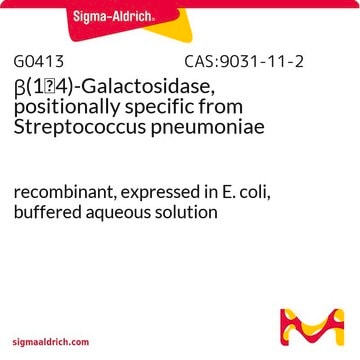N7271
α(2→3) Neuraminidase from Streptococcus pneumoniae
buffered aqueous solution
Sinónimos:
Acyl-neuraminyl Hydrolase, Acylneuraminyl hydrolase, Receptor-destroying enzyme, Sialidase
About This Item
Productos recomendados
origen biológico
Streptococcus pneumoniae
Nivel de calidad
formulario
buffered aqueous solution
concentración
≥5 units/mL
actividad extraña
β-Galactosidase, α-mannosidase, β-hexosaminidase, α-fucosidase, and proteases, none detected
Condiciones de envío
wet ice
temp. de almacenamiento
2-8°C
Información sobre el gen
Streptococcus pneumoniae R6 ... nanB(933504)
Categorías relacionadas
Acciones bioquímicas o fisiológicas
Envase
Definición de unidad
Forma física
Nota de preparación
Palabra de señalización
Danger
Frases de peligro
Consejos de prudencia
Clasificaciones de peligro
Resp. Sens. 1
Código de clase de almacenamiento
13 - Non Combustible Solids
Clase de riesgo para el agua (WGK)
WGK 1
Punto de inflamabilidad (°F)
Not applicable
Punto de inflamabilidad (°C)
Not applicable
Equipo de protección personal
Eyeshields, Gloves, type N95 (US)
Certificados de análisis (COA)
Busque Certificados de análisis (COA) introduciendo el número de lote del producto. Los números de lote se encuentran en la etiqueta del producto después de las palabras «Lot» o «Batch»
¿Ya tiene este producto?
Encuentre la documentación para los productos que ha comprado recientemente en la Biblioteca de documentos.
Los clientes también vieron
Artículos
Understand sialic acid structure, function, signaling, and modifications. Easily find products for sialic acid research.
Nuestro equipo de científicos tiene experiencia en todas las áreas de investigación: Ciencias de la vida, Ciencia de los materiales, Síntesis química, Cromatografía, Analítica y muchas otras.
Póngase en contacto con el Servicio técnico






